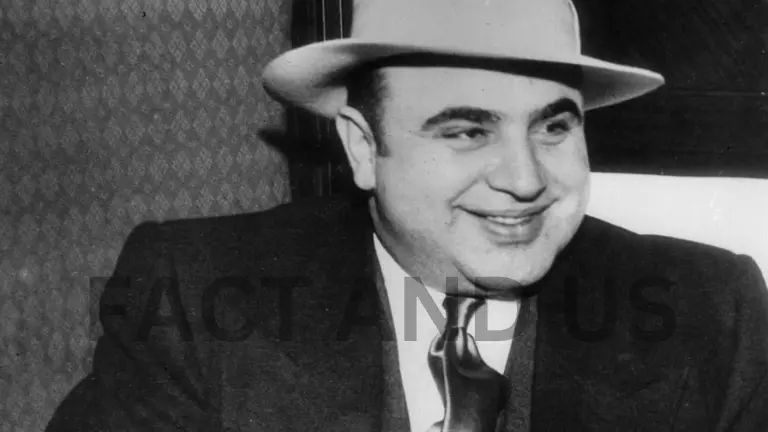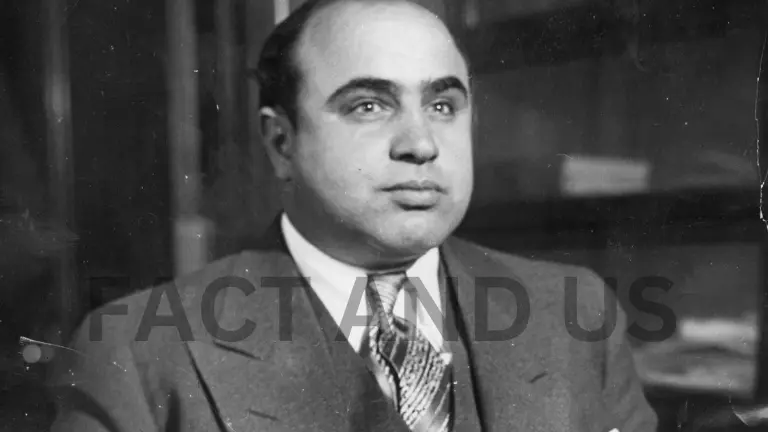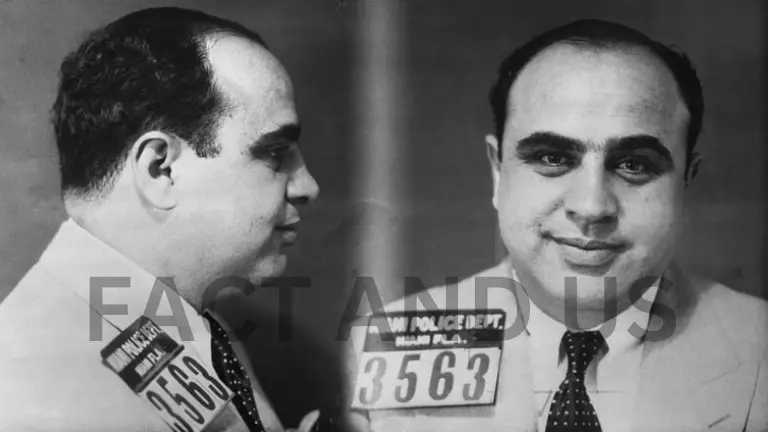Alphonse Gabriel Capone ( January 17, 1899 – January 25, 1947), sometimes known by the nickname “Scarface”, was an American gangster and businessman who attained notoriety during the Prohibition era as the co-founder and boss of the Chicago Outfit from 1925 to 1931. His seven-year reign as a crime boss ended when he went to prison at the age of 33.

Contents
Al Capone
Capone was born in New York City in 1899 to Italian immigrants. He joined the Five Points Gang as a teenager and became a bouncer in organized crime premises such as brothels. In his early twenties, Capone moved to Chicago and became a bodyguard and trusted factotum for Johnny Torrio, head of a criminal syndicate that illegally supplied alcohol—the forerunner of the Outfit—and was politically protected through the Unione Siciliana. A conflict with the North Side Gang was instrumental in Capone’s rise and fall. Torrio went into retirement after North Side gunmen almost killed him, handing control to Capone. Capone expanded the bootlegging business through increasingly violent means, but his mutually profitable relationships with Mayor William Hale Thompson and the Chicago Police Department meant he seemed safe from law enforcement.
Capone apparently reveled in attention, such as the cheers from spectators when he appeared at baseball games. He made donations to various charities and was viewed by many as a “modern-day Robin Hood”.[2] However, the Saint Valentine’s Day Massacre, in which seven gang rivals were murdered in broad daylight, damaged the public image of Chicago and Capone, leading influential citizens to demand government action and newspapers to dub Capone “Public Enemy No. 1”.
Federal authorities became intent on jailing Capone and charged him with twenty-two counts of tax evasion. He was convicted of five counts in 1931. During a highly publicized case, the judge admitted as evidence Capone’s admissions of his income and unpaid taxes, made during prior (and ultimately abortive) negotiations to pay the government taxes he owed. He was convicted and sentenced to eleven years in federal prison. After conviction, he replaced his defense team with experts in tax law, and his grounds for appeal were strengthened by a Supreme Court ruling, but his appeal ultimately failed. Capone showed signs of neurosyphilis early in his sentence and became increasingly debilitated before being released after almost eight years of incarceration. In 1947, he died of cardiac arrest after a stroke.
Early Years
Born of an immigrant family in Brooklyn, New York in January 1899, Al Capone quit school after the sixth grade and associated with a notorious street gang, becoming accepted as a member. Johnny Torrio was the street gang leader and among the other members was Lucky Luciano, who would later attain his own notoriety.
About 1920, at Torrio’s invitation, Capone joined Torrio in Chicago where he had become an influential lieutenant in the Colosimo mob. The rackets spawned by enactment of the Prohibition Amendment, illegal brewing, distilling and distribution of beer and liquor, were viewed as “growth industries.” Torrio, abetted by Al Capone, intended to take full advantage of opportunities. The mob also developed interests in legitimate businesses in the cleaning and dyeing field and cultivated influence with receptive public officials, labor unions, and employees’ associations.

Torrio soon succeeded to full leadership of the gang with the violent demise of Big Jim Colosimo, and Capone gained experience and expertise as his strong right arm.
In 1925, Capone became boss when Torrio, seriously wounded in an assassination attempt, surrendered control and retired to Brooklyn. Capone had built a fearsome reputation in the ruthless gang rivalries of the period, struggling to acquire and retain “racketeering rights” to several areas of Chicago. That reputation grew as rival gangs were eliminated or nullified, and the suburb of Cicero became, in effect, a fiefdom of the Capone mob.
The St. Valentine’s Day Massacre on February 14, 1929, might be regarded as the culminating violence of the Chicago gang era, as seven members or associates of the “Bugs” Moran mob were machine-gunned against a garage wall by rivals posing as police. The massacre was generally ascribed to the Capone mob, although Al himself was in Florida.
Career

New York City
Capone initially became involved with small-time gangs that included the Junior Forty Thieves and the Bowery Boys. He then joined the Brooklyn Rippers, and then the powerful Five Points Gang based in Lower Manhattan. During this time he was employed and mentored by fellow racketeer Frankie Yale, a bartender in a Coney Island dance hall and saloon called the Harvard Inn. Capone inadvertently insulted a woman while working the door, and he was slashed with a knife three times on the left side of his face by her brother, Frank Galluccio; the wounds led to the nickname “Scarface”, which Capone loathed. The date when this occurred has been reported with inconsistencies. When Capone was photographed, he hid the scarred left side of his face, saying that the injuries were war wounds. He was called “Snarky” by his closest friends, a term for a sharp dresser.
Move to Chicago
In 1919, Capone left New York City for Chicago at the invitation of Torrio, who was imported by crime boss James “Big Jim” Colosimo as an enforcer. Capone began in Chicago as a bouncer in a brothel, which is thought to be most likely where he contracted syphilis. Capone was aware of being infected at an early stage and timely use of Salvarsan probably could have cured the infection, but he apparently never sought treatment. In 1923, Capone purchased a small house at 7244 South Prairie Avenue in the Park Manor neighborhood in Chicago’s South Side for US$5,500.
As originally reported in the Chicago Tribune, hijacker Joe Howard was killed on May 8, 1924, after he tried to interfere with the Capone-Torrio bootlegging business. (In a 1936 article highlighting Capone’s criminal career, the Tribune erroneously reported the date as May 7, 1923.) In the early years of the decade, Capone’s name began appearing in newspaper sports pages where he was described as a boxing promoter. Torrio took over Colosimo’s criminal empire after the latter’s murder on May 11, 1920, in which Capone was suspected of being involved.
Early life
Alphonse Gabriel Capone was born in Brooklyn, a borough of New York City, on January 17, 1899. His parents were Italian immigrants Gabriele Capone (1865–1920) and Teresa Capone (née Raiola; 1867–1952).His father was a barber and his mother was a seamstress, both born in Angry, a small comune outside of Naples in the Province of Salerno. Capone’s family had immigrated to the United States in 1893 by ship, first going through Fiume (modern-day Rijeka, Croatia), a port city in what was then Austria-Hungary. The family settled at 95 Navy Street, in the Navy Yard section of Brooklyn. When Al was aged 11, he and his family moved to 38 Garfield Place in Park Slope, Brooklyn.
Capone’s parents had eight other children: James Vincenzo Capone, who later changed his name to Richard Hart and became a Prohibition agent in Homer, Nebraska; Raffaele James Capone, also known as Ralph Capone or “Bottles”, who took charge of his brother’s beverage industry; Salvatore “Frank” Capone; Erminia Capone, who died at the age of one; Erminia “John” Capone; Albert Capone; Matthew Capone and Mafalda Capone. Ralph and Frank worked with Al Capone in his criminal empire. Frank did so until his death on April 1, 1924. Ralph ran Capone’s bottling companies (both legal and illegal) early on and was also the front man for the Chicago Outfit until he was imprisoned for tax evasion in 1932.
Al Capone showed promise as a student but had trouble with the rules at his strict parochial Catholic school. His schooling ended at the age of 14 after he was expelled for hitting a female teacher in the face. Capone worked at odd jobs around Brooklyn, including a candy store and a bowling alley. From 1916 to 1918 he played semi-professional baseball.Following this, Capone was influenced by gangster Johnny Torrio, whom he came to regard as a mentor.
The Bureau Gets Involved
The investigative jurisdiction of the Bureau of Investigation during the 1920s and early 1930s was more limited than it is now, and the gang warfare and depredations of the period were not within the Bureau’s investigative authority.
The Bureau’s investigation of Al Capone arose from his reluctance to appear before a federal grand jury on March 12, 1929 in response to a subpoena. On March 11, his lawyers formally filed for postponement of his appearance, submitting a physician’s affidavit dated March 5, which attested that Capone had been suffering from bronchial pneumonia in Miami, had been confined to bed from January 13 to February 23, and that it would be dangerous to Capone’s health to travel to Chicago. His appearance date before the grand jury was re-set for March 20.
On request of the U.S. Attorney’s Office, Bureau of Investigation agents obtained statements to the effect that Capone had attended race tracks in the Miami area, that he had made a plane trip to Bimini and a cruise to Nassau, that he had been interviewed at the office of the Dade County Solicitor, and that he had appeared in good health on each of those occasions.
Arrest and Convictions
Capone appeared before the federal grand jury in Chicago on March 20, 1929 and completed his testimony on March 27. As he left the courtroom, he was arrested by agents for contempt of court, an offense for which the penalty could be one year in prison and a $1,000 fine. He posted $5,000 bond and was released.
On May 17, 1929, Al Capone and his bodyguard were arrested in Philadelphia for carrying concealed deadly weapons. Within 16 hours they had been sentenced to terms of one year each. Capone served his time and was released in nine months for good behavior on March 17, 1930.
On February 28, 1931, Capone was found guilty in federal court on the contempt of court charge and was sentenced to six months in Cook County Jail. His appeal on that charge was subsequently dismissed.
Meanwhile, the U.S. Treasury Department had been developing evidence on tax evasion charges—in addition to Al Capone, his brother Ralph “Bottles” Capone, Jake “Greasy Thumb” Guzik, Frank Nitti, and other mobsters were subjects of tax evasion charges.
On June 16, 1931, Al Capone pled guilty to tax evasion and prohibition charges. He then boasted to the press that he had struck a deal for a two-and-a-half year sentence, but the presiding judge informed him he, the judge, was not bound by any deal. Capone then changed his plea to not guilty.
On October 18, 1931, Capone was convicted after trial and on November 24, was sentenced to eleven years in federal prison, fined $50,000 and charged $7,692 for court costs, in addition to $215,000 plus interest due on back taxes. The six-month contempt of court sentence was to be served concurrently.
While awaiting the results of appeals, Capone was confined to the Cook County Jail. Upon denial of appeals, he entered the U.S. Penitentiary in Atlanta, serving his sentence there and at Alcatraz.
Release From Prison
On November 16, 1939, Al Capone was released after having served seven years, six months and fifteen days, and having paid all fines and back taxes.
Suffering from paresis derived from syphilis, he had deteriorated greatly during his confinement. Immediately on release he entered a Baltimore hospital for brain treatment and then went on to his Florida home, an estate on Palm Island in Biscayne Bay near Miami, which he had purchased in 1928.
Following his release, he never publicly returned to Chicago. He had become mentally incapable of returning to gangland politics. In 1946, his physician and a Baltimore psychiatrist, after examination, both concluded Capone then had the mentality of a 12-year-old child. Capone resided on Palm Island with his wife and immediate family, in a secluded atmosphere, until his death due to a stroke and pneumonia on January 25, 1947.
Bibliography on Al Capone
- “Farewell, Mr. Gangster!” Herbert Corey, D. Appleton-Century Company, Inc., New York, New York, 1936
- “The FBI Story,” Don Whitehead, Random House, New York, New York, 1956
- “Organized Crime In America,” Gus Tyler, University of Michigan Press, Ann Arbor, Michigan, 1962
- “The Dillinger Days,” John Toland, Random House, New York, New York, 1963
- “The Devil’s Emissaries,” Myron J. Quimby, A. S. Barnes and Company, New York, New York, 1969
- “Capone,” John Kobler, G. P. Putnam’s Sons, New York, New York, 1971
- “Mafia, USA,” Nicholas Gage, Dell Publishing Company, Inc., New York, New York, 1972
- “The Mobs And The Mafia,” Hank Messick and Burt Goldblatt, Thomas Y. Crowell Company, New York, New York, 1972
- “Bloodletters and Badmen,” Jay Robert Nash, M. Evans and Company, Inc., New York, New York, 1973
- “G-Men: Hoover’s FBI in American Popular Culture,” Richard Gid Powers, Southern Illinois University Press, Carbondale, Illinois, 1983.
Stay connected with Fact and US for more such news.
